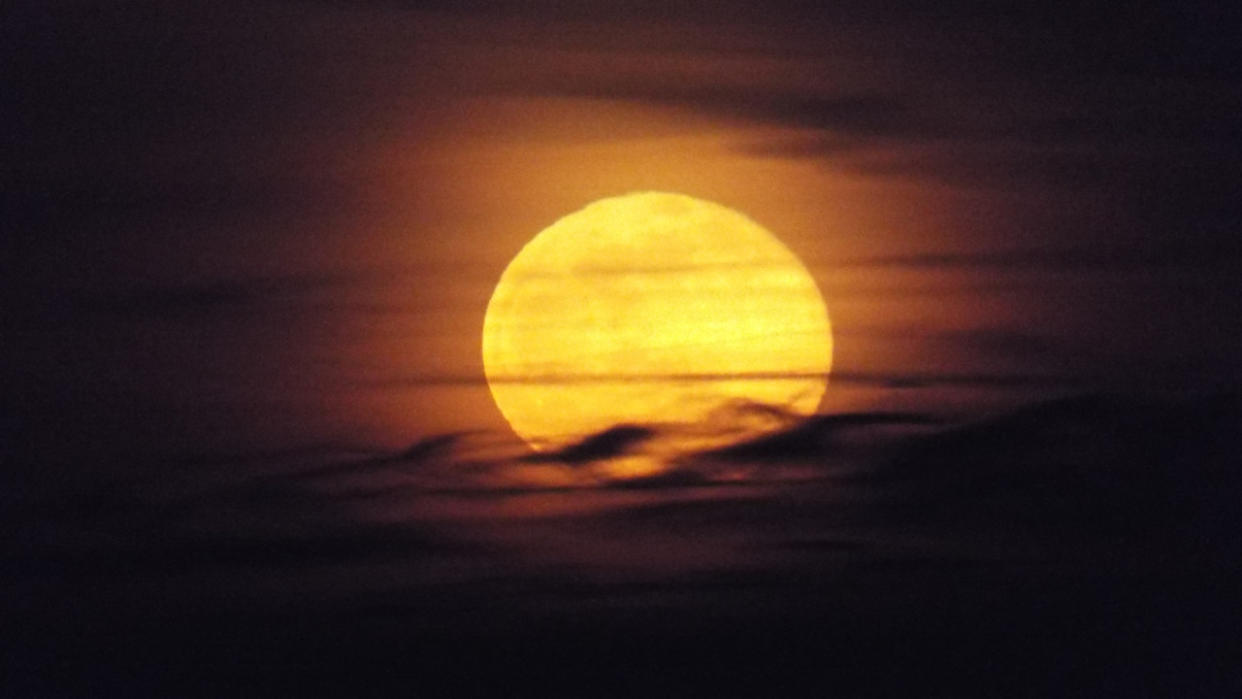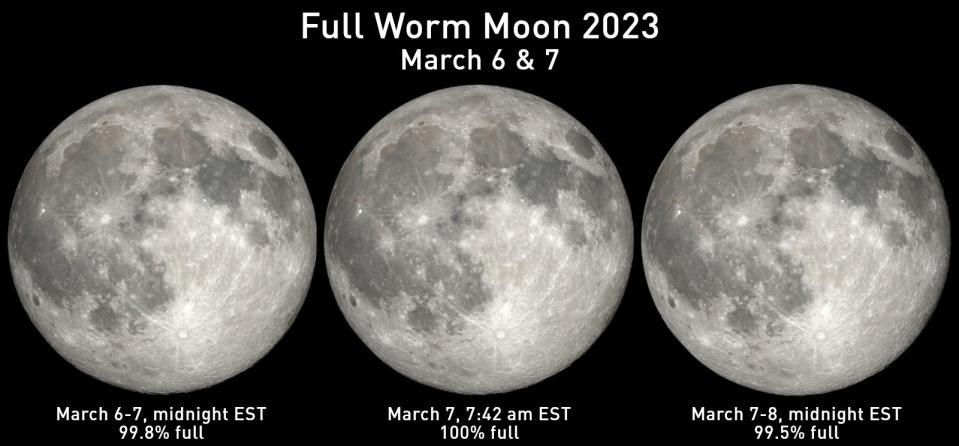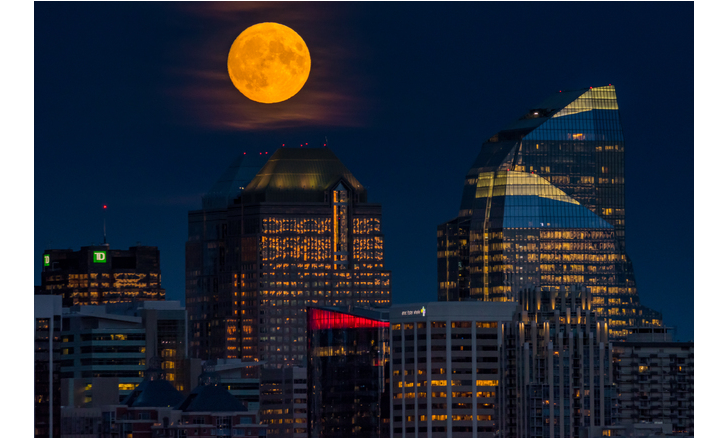Look up! The Full Worm Moon to illuminate the night sky

If you have clear skies tonight and Tuesday night, set aside a few minutes to go out and observe the Full Worm Moon.
On the nights of March 6 and 7, 2023, the Full Moon is up all night long, rising around sunset and setting near dawn. Check your local forecast to see if your sky conditions are right for viewing the night sky.
What is a 'Worm Moon'?
Throughout history, human cultures have named many things and Full Moons are no exception.

This graphic collects all the relevant data about the 13 Full Moons of 2023, including their popular names, whether they are a 'super' or 'micro' Moon, a perigee or apogee Full Moon, and whether they are remarkable in some other way (Lunar Eclipse, Blue Moon, or Harvest Moon). Credit: NASA's Scientific Visualization Studio/Fred Espenak/Scott Sutherland
Each Full Moon has a popular name. These were originally gathered together from First Nations, Colonial, and European folklore, and have been published by the various Farmers' Almanacs over the years.
The March Full Moon is most commonly called the Full Worm Moon.
"For many years, we thought this name referred to the earthworms that appear as the soil warms in spring," The Old Farmer's Almanac states on their website.
"However, more research revealed another explanation," they added. "In the 1760s, Captain Jonathan Carver visited the Naudowessie (Dakota) and other Native American tribes and wrote that the name Worm Moon refers to a different sort of 'worm' — beetle larvae — which begin to emerge from the thawing bark of trees and other winter hideouts at this time."
Some First Nations peoples named this moon after animals, such as the goose (the Haida), the eagle (the Cree), the frog (the Omaha), or the crane (the Potawatomi). For others, it was a time of hunting moose (the Abenaki) or catching fish (the Algonquin). The various Sioux people, such as the Assiniboine, Dakota, Lakota, and Nakota named it the "sore eyes moon" — referring to the snow blindness that comes from sunlight reflecting off snow and ice.
It's important to note that these names are not specifically for the Full Moon alone. Many First Nations peoples tracked the year using a lunar calendar. A moon name, therefore, referred both to the Full Moon and the 29-day period ('lunation') until the next Full Moon.
Monday AND Tuesday night?
Usually we talk about the Full Moon occurring on one specific night of the month. So, why is this Full Moon visible for two nights?
On each orbit of the Moon, there comes one moment when it reaches a point on exactly the opposite side of Earth from the Sun. This is the point that astronomers call the Full Moon. For the few days and hours before that, it is a Waxing Gibbous Moon and for the few hours and days after, it is a Waning Gibbous Moon.
However, the exact timing of the Full Moon doesn't always happen at night across North American time zones. Also, in the hours on either side of a Full Moon, the Waxing or Waning Gibbous Moon can still appear to be Full to the unaided eye.
This month, the Full Moon occurs at roughly 7:42 a.m. EST on the 7th.

The Full Moon at midnight EST on March 6-7, at 7:42 a.m. EST on March 7, and at midnight EST March 7-8. Can you see the difference? Credit: NASA's Scientific Visualization Studio/Scott Sutherland
With this timing, when we look up at the Moon on the night of March 6-7, it will appear over 99 per cent full. Also, when the Moon rises on the night of March 7-8, it will still be over 99 per cent full, and it will remain so until early Wednesday morning.
If you have a telescope or a pair of binoculars, you can look more closely and likely see a tiny bit of shadowing on the Moon's eastern limb (left side) on Monday night, and a bit of shadowing on the western limb (right side) on Tuesday night. To the unaided eye, though, it can appear as though the Moon is full on both nights.
Biggest & brightest of 2023, so far
If it seems that this Full Moon is bigger and brighter than those from the past couple of months, it's not your imagination.
Due to the Moon's elliptical orbit around Earth, there is a yearly cycle for Full Moons — one among them is the farthest and smallest of the year (the 'apogee micromoon'), then each Full Moon after appears larger and brighter than the last until we see the closest and largest of the year ('perigee supermoon') about six months later, and after that the Full Moons appear smaller and dimmer until the next apogee micromoon.
In 2023, February's Full Snow Moon happened to be this year's apogee micromoon. So, starting with this Full Moon, each appears larger and brighter until the Perigee Super Blue Moon at the end of August.
The Magnificent Moon Illusion
However, there can be an imaginary component to how big the Moon appears. If you look up at it just after moonrise or just before moonset it can seem exceptionally big, due to a little trick of our mind known as The Moon Illusion.
As we observe the world around us, our brain knows from experience that objects close-by tend to appear larger and in focus. In contrast, distant objects are usually tiny and blurry. By bridging the gap between these two concepts, the brain therefore "knows" that for a distant object to appear in focus, it must be very large.

This close-up of the Harvest Moon was snapped in Calgary, AB, on September 13, 2019. Credit: Siv Heang
So, when we see a bright Full Moon hanging in the sky above the horizon — crisp and clear and in focus — while at the same time, all of the objects on the ground become smaller and blurrier the closer they are to the horizon, the combination leaves us standing on that aforementioned bridge that the brain has built.
To compensate, the brain interprets the Full Moon as being much bigger than it truly is. To be clear, the Moon is certainly much larger than any of the objects on the horizon (it's 3,474 km across), but this 'illusion' makes the Moon appear huge!
Look up into the sky closer to the middle of the night, and the Moon will be high above our heads. Usually, it will be the only thing we see, other than the stars and maybe a few planets. At that time, the brain is focused only on the Moon, and without the other objects in the field of view to complicate matters, it is free to just see its actual size.

This zoomed-in image of the Full Snow Moon was captured from Salisbury, NB, on February 9, 2020, and uploaded into the Weather Network's UGC gallery. Credit: Darlene MacLeod/Smith
It's quite challenging to see past this illusion. There are a couple of tricks that can help cancel it out, though.
For the first one, just go outside after sunset and find the Moon near the horizon. Stretch your arm out towards it, and cover the Moon over with the tip of a finger or thumb (whichever is closest to the size of the Moon). Note how big the Moon looks compared to the digit in question, and keep that in mind. Maybe even take a picture of it, if you want. Later in the night, check out the Moon again when it's high in the sky. It may appear smaller than when you saw it earlier, but repeat what you did earlier, and cover it over with your finger or thumb. Compare it with what you saw before, and you'll find that the Moon is actually precisely the same size at both times.
There is a way technology can help us, though. When the Moon is low on the horizon, take out your cell phone, turn your camera on, and point it at the Moon. Note: it is possible for the Moon illusion to still work on us when looking at a picture or video. This is because the brain will make the same judgments of distance, blurriness, and size as it did when looking at a 'live' scene. Still, directly comparing what we see in the sky at that time to what is shown on our small cell phone screen can help put things into better perspective. Plus, you can also take a few pictures to upload into the Weather Network UGC Gallery while you're at it!
Watch Below: See every phase of the Moon for 2023 in under 5 minutes
Thumbnail image courtesy Ronnie B, who shared this March Full Moon image from Thunder Bay in our UGC gallery.

